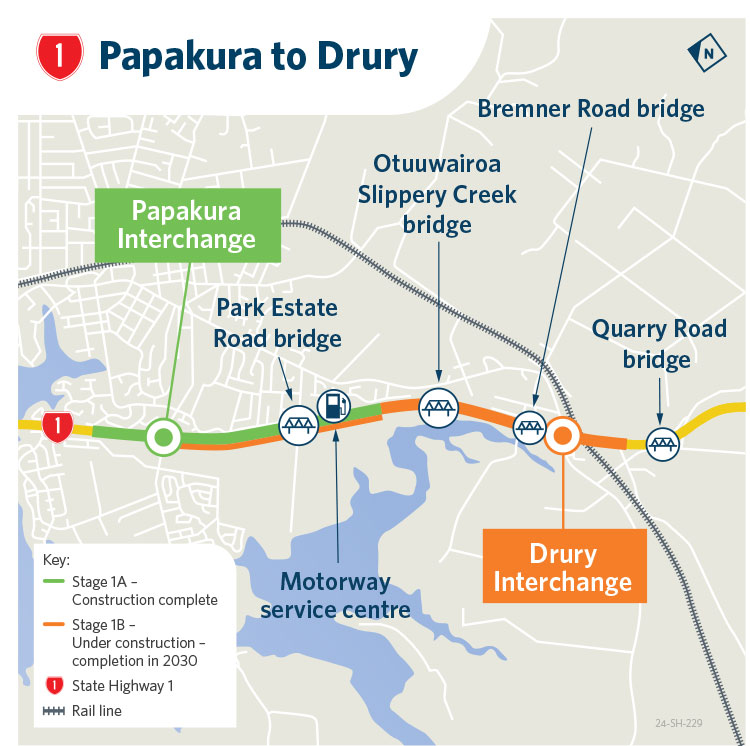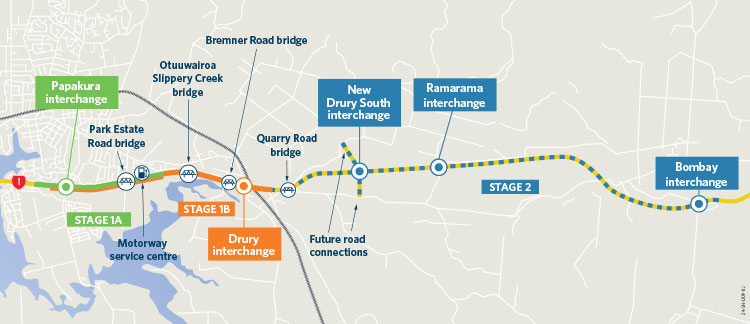Project updates
We send out regular updates on the SH1 Papakura to Drury / Papakura to Bombay project. If you would like to receive these updates, subscribe using the link to our sign up form below.
Subscribe to project updates(external link)
Traffic notices
Traffic notices provide a brief overview of temporary night closures and road layout changes for the coming week. If you would like to receive these updates, please subscribe using the link to our sign up form below.
Over the next 30 years, southern growth areas such as Pukekohe, Drury, Paerātā, and Takaanini, could provide up to 40,000 new homes, as well as new jobs. Investing in roading improvements play an important part in building a strategic transport network which reinforces the Southern Motorway’s function to support national and regional economic growth, meeting the needs of the people who live, work and travel in the area.
NZ Transport Agency Waka Kotahi (NZTA) and KiwiRail are constructing key transport improvement projects in South Auckland including SH1 improvements between Papakura and Drury, rail electrification to Pukekohe (commissioning expected in early 2025) and three new rail stations at Drury, Ngākōroa and Paerātā.
The SH1 Papakura to Drury project’s improvements will support economic growth by improving access along and across the motorway, enhancing local connectivity and resilience and allowing people and goods to get where they want to go more efficiently with more reliable journeys.
As part of the Papakura to Drury project, a walking and cycling path will be built next to the Southern Motorway, alongside the northbound lane.
It will extend the Southern Path opened in May 2021 as part of the Southern Corridor Improvements project.
CloseProtecting and enhancing the local environment is a prime consideration in our project planning.
This includes protecting and enhancing areas of environmental and heritage significance.
The project will ensure 100% treatment of stormwater from new and existing impervious surfaces within the project area to improve local water quality.
Flooding to the east of SH1 along Chichester Drive has been identified through consultation with Auckland Council. This flooding will be alleviated by replacing culvert pipes crossing under the motorway with larger sized ones, allowing more water to flow through.
The project is required to complete and maintain Infrastructure Sustainability Council (ISC) certification. The ISC system is an international sustainability rating tool that is designed to drive good sustainability outcomes.
CloseCoordination with Auckland Council and Auckland Transport, as well as interest groups and community groups, will ensure that the project recognises cultural history and utilises local knowledge to help the project team understand the areas it is working in and how best to design for safety and accessibility.
CloseThe Papakura to Drury section (Stage 1) of the wider Papakura to Bombay project was consented in three stages and is being delivered with Crown funding as a Road of Regional Significance.

Construction began on Stage 1A (green) in April 2021 and was completed in August 2024 except for final resurfacing in asphalt, undertaken in October/November 2024. This stage comprised widening and upgrades to the motorway between Papakura and the BP motorway service centre and a new (second) southbound on-ramp at Papakura.
Stage 1B (orange) construction officially begins in December 2024, noting work began on an ‘early works’ package in September 2024. (Note: three new bridges were also built over the rail line at Drury Interchange ahead of KiwiRail’s electrification of the line, which were completed in early 2024.)
Stage 1B includes Oopaheke, an identified site of cultural significance spanning both sides of the motorway at Otuuwairoa / Slippery Creek.
Design plans showing plans for Stage 1

Stage 2 of the wider Papakura to Bombay project is a planning project that will protect the route and land required for future improvements to the SH1 Southern Motorway between Drury and Bombay. There is currently no funding earmarked for the delivery of Stage 2, meaning there is no confirmed timeframe for construction at this stage.
Route protection questions and answers [PDF, 214 KB]
NZTA lodged its Notices of Requirement for Stage 2 of the project with Auckland Council in mid-February 2024. This step began a statutory process under the Resource Management Act 1991 that will provide greater certainty for the community and landowners of NZTA’s transport plans in the area, and protect the land required for future motorway improvements.
The Notices of Requirement for Stage 2 were notified by Auckland Council on 14 June 2024 and the public was invited to make submissions. A Hearing before an Independent Hearing Panel appointed by Council was held in Pukekohe on 20-21 November 2024 and the Panel’s formal report and recommendations were notified on 9 May 2025. NZTA notified its decision on the recommendations to Auckland Council on 24 June 2025, and Council will notify submitters and affected landowners and occupiers.
Design plans showing plans for Stage 2 [PDF, 13 MB]
During the development of its proposals, NZTA engaged with potentially affected property owners to understand how they used their land and how the project design might be refined to reduce the impact on their properties. We will continue our engagement with property owners as the design of the project progresses further.
Property owners of land affected by an NZTA Notice of Requirement or designation and looking to develop or change the current use of their land should contact us early to discuss their proposals. Find out more information here:
Developing land near the state highway network
Contact NZTA’s environmental planning team on environmentalplanning@nzta.govt.nz